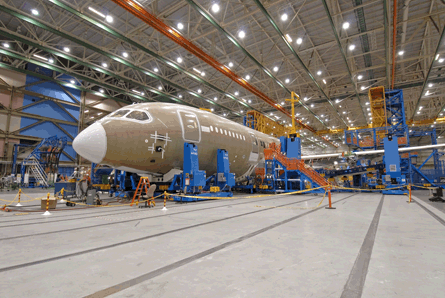US Federal Aviation Administration regulators are taking action to address four safety-related concerns linked to the repair and maintenance of largely composite aircraft such as the Boeing 787, after the issues were highlighted by a US government monitor.
The Government Accountability Office (GAO) studied how the FAA and the European Aviation Safety Agency (EASA) certificated the 787 - approval for which was granted in August 2011.
The US airframer made the first delivery of the aircraft in late September, to Japan's All Nippon Airways. The carrier then accidentally inflicted minor surface damage on the twinjet, after a bump during operational tests.
Composite material will also make up more than 50% of the Airbus A350.
"Although composites are lighter and stronger than most metals, their increasing use in commercial airplane structures such as the fuselage and wings has raised safety concerns," the GAO said, outlining the reasons behind its study.
 |
|---|
© Boeing Composite materials make up over 50% of Boeing's new 787 (above) as well as Airbus' new A350XWB |
It also noted that the FAA and EASA certificate new aircraft against existing safety standards, which are often based on the performance of metallic aircraft.
While the GAO did not make any recommendations, it found four safety-related concerns. There is limited information on the behaviour of aircraft composite structures, it said. This is largely due to the fact that there is little in-service experience information available for composite airplane structures.
The GAO also found challenges related to the detection of damage in composite materials. "Impact damage to composite structures is unique in that it may not be visible or may be barely visible, making it more difficult for a repair technician or aviation worker to detect than damage to metallic structures," the GAO said.
In addition, there is limited standardisation of composite materials and repair techniques, compared to metal materials and repairs. This is partly due to business proprietary practices and the "relative immaturity" of the use of composite materials in aircraft structures. "A repair technician could confuse materials or processes, which may result in improper repairs," the GAO said.
The organisation also identified concerns related to the level of training and awareness of workers handling composites. "Airplane repair technicians and designers that have worked with metal materials for decades generally may not be as familiar with composite materials, [as its] application in airplanes is relatively recent, and [its] unique characteristics are associated with technical challenges," it said.
But the GAO noted that the FAA had applied five special conditions while assessing the 787, when it found that its airworthiness standards were not enough to ensure that the composite structures would comply with existing safety standards.
These conditions required Boeing to take additional steps to show that the aircraft would meet performance standards, the GAO added.
"[The] FAA also granted Boeing an equivalent level of safety finding when the manufacturer determined it could meet the standard, but prove it differently from the method specified in that standard," the office said.
"[The] GAO found that [the] FAA followed its process by documenting the technical issues related to the design of the composite fuselage and wings, determining the special conditions and equivalent level of safety finding, obtaining public comments on draft special conditions and monitoring Boeing's compliance with those conditions."
The GAO noted that the FAA is taking ongoing action to address the safety-related concerns it identified. These actions include new or modified policy, research, developing training and working with industry stakeholders.
"Until these composite airplanes enter service, it is unclear if these actions will be sufficient," the GAO said, adding that it is too early to assess if the FAA's actions are adequate.
"However, the increased use of composite materials in airplanes may exacerbate some of these weaknesses - and their associated risks - if [the] FAA does not take appropriate corrective steps."
Source: Flight International























